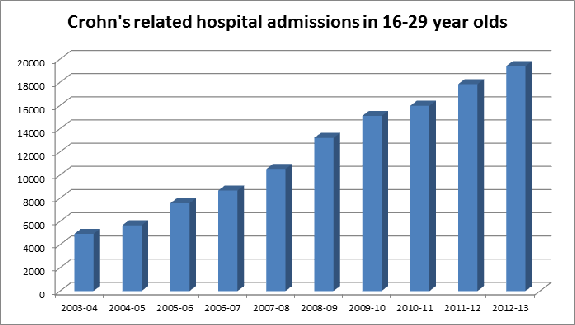

GLASGOW COLORECTAL CENTRE
Scotland’s Best Private Colorectal Surgery & Colonoscopy Clinic
info@colorectalcentre.co.uk
If you have any questions, call Catherine on 0735 506 6597

© Glasgow Colorectal Centre. All Rights Reserved

 Book an Appointment
Book an Appointment
Any questions? Call Catherine on 0735 506 6597
Info@colorectalcentre.co.uk
A recent study from the Health and Social Care Information Centre (a government body), showed a dramatic rise in Crohn's related annual hospital admission rates for 16-
The data covers the period 2003 -
The study did not examine the reasons for this change in practice. At first glance, the data might appear to suggest that the incidence of Crohn’s disease is increasing. However, a number of other factors may also influence these results. Specifically, improvements in diagnosis and the documentation/recording of the diagnosis for statistics purposes may have had an impact the results. In addition, in the middle of the study period (2006-

Information for the Health & Social Care Info Centre
Although it is very likely that changes and improvements in the documentation and recording of the diagnosis will account for much of the so-
Crohn’s disease can be caused by a number of conditions (these are discussed in more detail on our dedicated web page for Crohn’s disease or on Crohn’s information sheet). However, it is generally felt that the disease is multi-
- Environmental factors. Crohn’s disease is very common in Western society and in particular in the UK. Crohn’s disease occurs more frequently in some parts of the Scottish mainland and the Scottish Isles. It is also interesting to note that populations who come from areas where there is a low incidence such as Africa are likely to develop a higher incidence when they have lived in a Western environment for some years. This suggests that environmental factors are contributing to the development of the condition. Some researchers have also begun to examine the role of diet and the development of Crohn’s disease. Early studies suggest that eating a lot of high calorie junk food may play a role. Others have looked at the possible role of antibiotics in precipitating Crohn’s disease. However, there is no conclusive evidence that any changes in diet account for these results. It would be wrong to assume, as has been reported in the media, that eating a “junk food diet” and antibiotic use are responsible.
- Smoking. Although it’s not clear if smoking itself can cause this condition, there is very good evidence that patients who smoke and have Crohn’s disease may have more severe disease and it is also much more likely to come back more quickly in smokers who have undergone surgery for Crohn’s disease.
- Genetics – family history. In some patients, there may be a strong family history of Crohn’s disease, or other types of inflammatory bowel disease.
- Abnormal immune response. It is likely that Crohn’s disease develops because of abnormal immune response to some agent, condition or infection. This is the reason that the disease is treated with drugs that alter this immune response. Crohn’s disease is similar to other autoimmune disorders such as rheumatoid arthritis, ulcerative colitis, psoriasis and ankylosing spondylitis. It is also closely related to arthritis and ankylosing spondylitis and indeed the two may occur together. Crohn’s disease is also associated with other immune related conditions such as the sclerosing cholangitis which can affect the liver
- Previous infections. It has been suggested that the term exposure to certain types of infection may predispose the development of Crohn’s disease. A lot of research has been performed to look at the importance of early viral infections such as measles. Others have looked at the possible effect of vaccinations. The jury however is still out and we are not entirely clear about the importance of the role of infection in triggering an abnormal immune response.
Where can I get more information about Crohn’s disease or ulcerative colitis?
Crohn’s and Colitis UK
4 Beaumont House, Sutton Road,
St Albans, Herfordshire
AL1 5HH
Administration: 01727 830038 -
e-
web -
A UK patient orientated organisation. Provides useful information for patients with Crohn’s and colitis. Organisation had local branches and is also involved in fundraising
The Colostomy Association
www.colostomyassociation.org.uk
0800 328 4257
UK charity providing support, practical information for patients with a colostomy
The Ileostomy Association
A UK charity providing support, funding raising for research and information for patients who have had their colon removed and have either an ileostomy or ileoanal pouch
Dramatic rise in Crohn’s related hospital admissions in young adults (June 2014)
